Title of paper under discussion
Learning to Play the Violin: Motor Control by Freezing, Not Freeing Degrees of Freedom
Authors
Jürgen Konczak, Heidi van der Velden, Lukas Jaeger
Journal
Journal of Motor Behavior, 2009, Vol. 41, No. 3, pp243–252
Link to paper (free access)
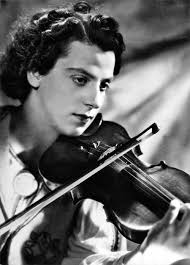
Overview
Do beginner violinists start with restricted movement in all aspects of their bowing arm joints, and then learn to free up the movements that produce tone? Or do they start with free movement in all joints and then learn to restrict the movements that threaten tone production?
Jürgen Konczak and colleagues from the University of Minnesota explored this question by taking group of Suzuki-trained violinists, aged 4 to 47, back to the very first piece they learned, variations on Twinkle Twinkle Little Star.
Looking at two joint actions that produce tone – elbow flexion/extension and shoulder abduction/adduction – they found no patterns of either suppression or freeing as the players became more advanced.
But a joint action that interferes with maintaining a straight bow – shoulder flexion/extension – was found to be progressively suppressed according to a player’s cumulative practice hours.
In the words of the authors “The findings imply that restricting joint amplitude at selected joint degrees of freedom [actions], while leaving other degrees of freedom [actions] unconstrained, constitutes an appropriate strategy for learning complex, high-precision motor patterns in children and adults.”
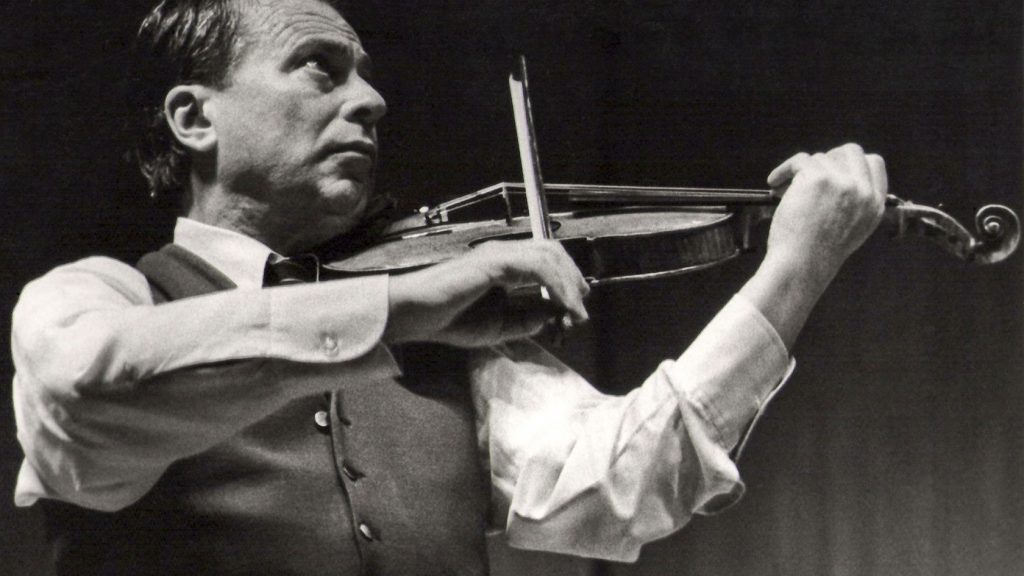
Introduction
Although the arm (excluding the fingers) has three joints – the shoulder, elbow and wrist – it has seven ‘degrees of freedom’, meaning it can move courtesy of seven different joint actions: shoulder rotation, shoulder flexion/extension, shoulder adduction/abduction, elbow flexion/extension, forearm supination/pronation, wrist flexion/extension and wrist adduction/abduction (or radial/ulnar deviation). [Here is more detail on those types of movements.]
Received wisdom from students of human movement, especially from the ‘father of biomechanics’ Nikolai Bernstein, has it that in order to learn a motor skill (be it handwriting, a golf swing, or whatever) the motor system needs to eliminate ‘redundant’ joint actions by ‘fixating or freezing’ those movements. ‘Freezing’ doesn’t mean a full locking of the joint or imply an increased joint stiffness or rigidity; it simply means, in this context, a reduction in that particular joint action’s amplitude or range of movement. Such ‘freezing’ then, according to Bernstein, simplifies the ‘kinematic chain’ and makes the motor task easier to control.
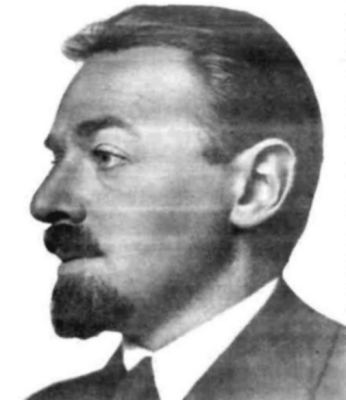
Some research into the process of acquiring a motor skill points to an initial freezing of joints, followed by an unlocking of the task-specific actions as experience grows. For example, in one study novice skiers “initially locked some joints but began to unlock their stiffened joints as they gained experience”. Another study, this time into football, saw “that novice learners implemented a strategy of joint freezing during the initial phase of practising a soccer chip.”
But, according to our authors, other researchers contend that motor-skill acquisition in humans should be viewed as “a process of selectively recruiting and suppressing” different joint actions as that skill is honed. That approach “has been shown to be more successful in robot motor learning than the gradual release of previously frozen degrees of freedom.”
When it comes to the violinist’s bowing arm, one particular joint action – shoulder flexion/extension, which sees the bow hand going forwards/backwards – needs stabilising (or ‘freezing’) in order for a player to maintain a straight bow. Changes in shoulder flexion/extension during performance threaten to send the bow off course.
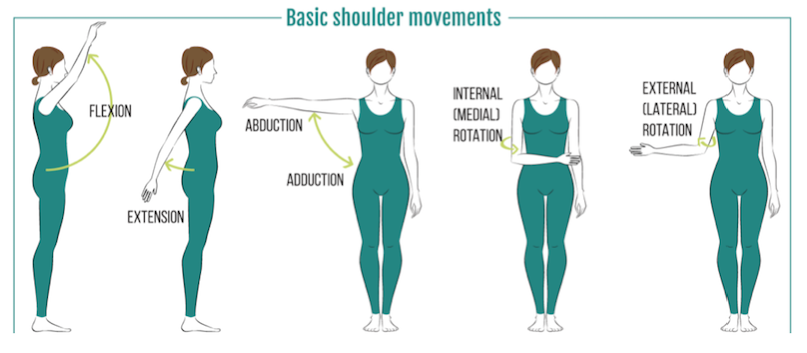
Our researchers looked at shoulder flexion/extension in novices compared with experienced players – was it frozen from lesson one or did players learn to freeze it as they became more advanced? The team also looked at elbow flexion/extension and shoulder adduction/abduction to see how these joint actions, which in comparison need freedom for good playing, developed as players progressed in standard.
Method
14 violinists (10 children and 4 adults), all originally pupils of the Suzuki Method, took part in the study. Each (or a parent) was asked how many violin practice hours they had behind them.
In order to track each violinist’s various bowing arm joint actions and resultant bowing action during performance, small reflective balls were placed along the bowing arm and along the bow and violin. Using multiple cameras to trace the movements of these reflective balls – a ‘three-dimensional motion-capture system’ – the scientists were able to track the four angles of interest: shoulder extension/flexion (‘Shoulder X’ angle), shoulder abduction/adduction (‘Shoulder Y angle’), elbow extension/flexion (‘Elbow angle’) and finally the angle between the bow and the violin strings (‘bowing angle’):
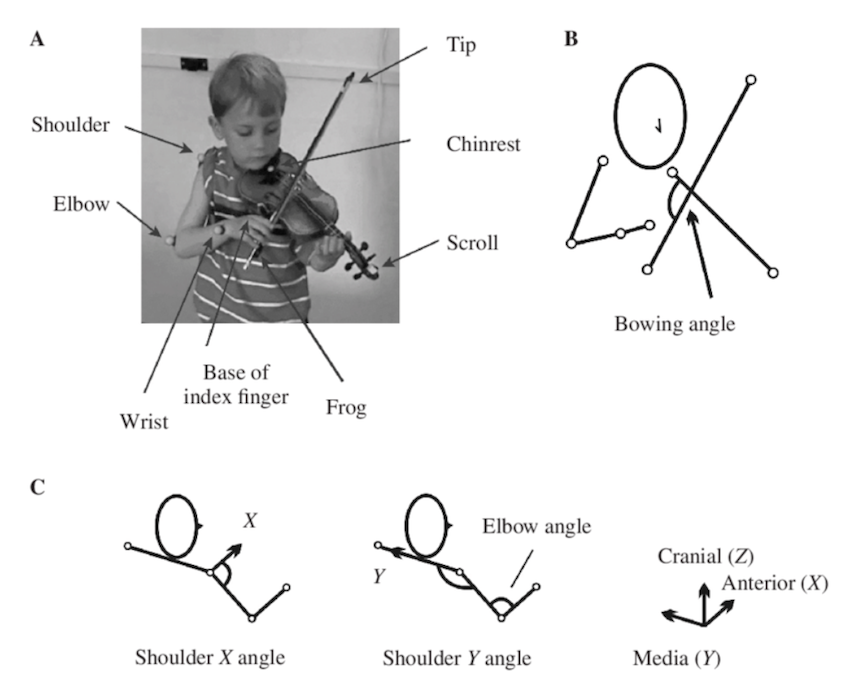
A typical pair of traces (‘shoulder adduction/abduction’ and ‘elbow extension/flexion’) is shown here alongside the relevant music:
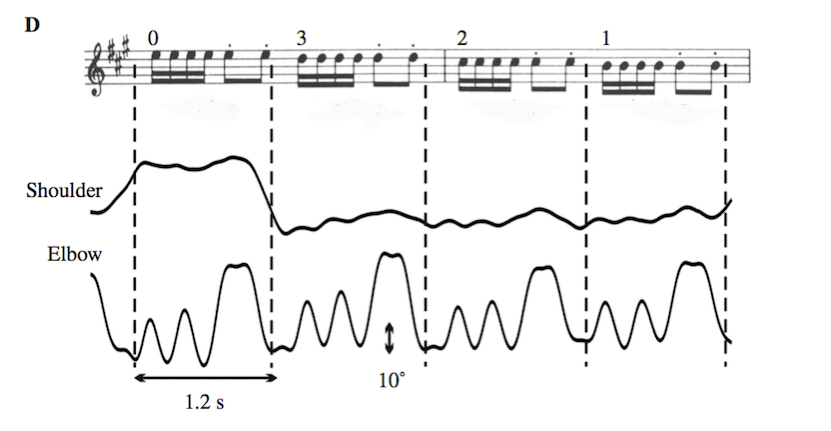
Results
1) relationship between expertise and bowing angle
The chart below presents 4 different players and describes each one’s bowing angles throughout a performance of “Twinkle Twinkle Variation A”. It transpired that the less experienced the player, the more variable was the bowing angle. So, for example, “Adult expert player” has been playing for 23.5 years and has nearly 25,000 practice hours behind him – he maintains a very constant, and close to perpendicular, angle throughout his performance; whereas “Child novice player”, playing for only 1.42 years and with only 272 hours practice behind her, displays a wide spread of constantly changing bowing angles:
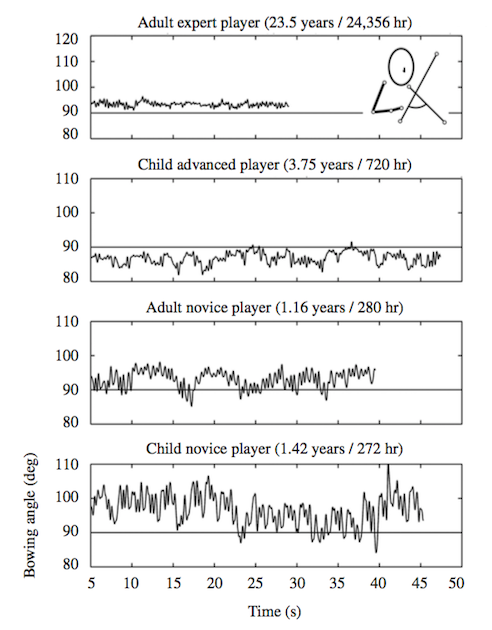
Taking the variability (‘standard deviation’ or ‘SD’) of each violinists’s bowing angle and plotting it against playing experience showed, as expected, a clear reduction in bowing angle variability as practice hours increased:
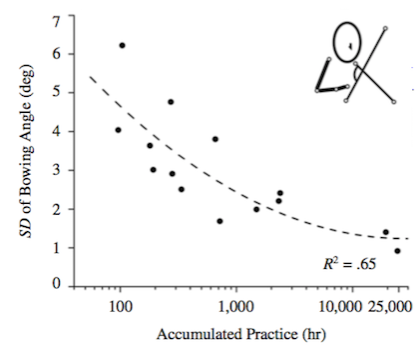
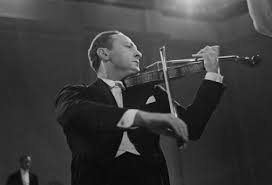
2) relationship between joint movements and bowing angle
The scientists postulated that shoulder flexion/extension, an action that brings the bowing hand forwards and backwards, would thereby affect bowing angle. A narrower range of shoulder flexion/extension, they argued, would be associated with a more consistent (of lower variability or ‘SD’) bowing angle. The plot (upper graph) below backs up that claim, showing the higher the shoulder flexion/extension range of movement (‘Shoulder X ROM’) the higher the bowing angle variability (‘SD of Bow Angle’). It also shows (lower graph) that range of elbow movement has no such effect on bowing angle:
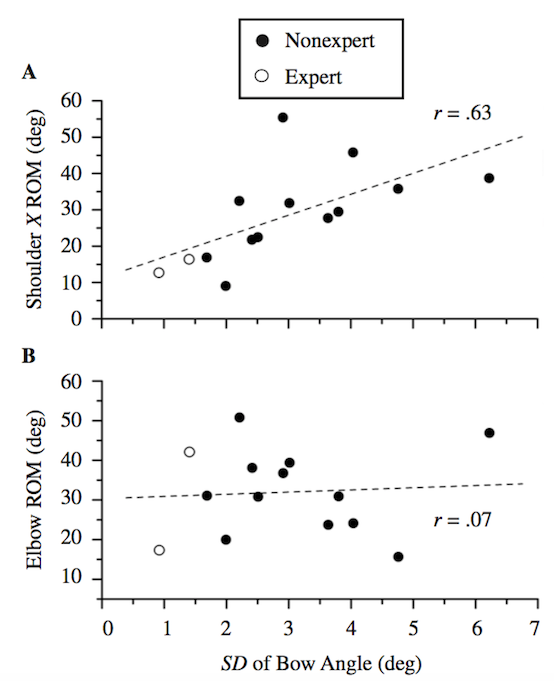
3) relationship between expertise and joint movements
Konczak and his team were expecting to find that the more expert the player, the less variable the shoulder flexion/extension angle because that particular action – bringing the bowing hand forwards and backwards – needs to be stabilised to maintain a constant bowing angle. In contrast, elbow flexion/extension and shoulder adduction/abduction are arm movements that create tone, though it is a matter of individual choice as to how much bow to use to create that tone – would violin experts, the scientists wondered, use more or less of these movements in their playing than beginners?
It turned out that a) experts did indeed show more restricted shoulder flexion/extension and b) there was no particular correlation between the other joint actions (elbow flexion/extension and shoulder adduction/abduction) and playing experience.
This is best illustrated by looking at some more traces. The next diagram shows the elbow extension/flexion (bowing hand thereby moving right and left) plotted against the shoulder extension/flexion (bowing hand thereby moving forwards and backwards) of three of the players (child beginner, child advanced and adult expert). It is clear that as a player becomes more advanced the range of shoulder flexion/extension (along the y axis) narrows, but the range of elbow use (along the x axis) is more or less the same in a beginner as it is in an expert:
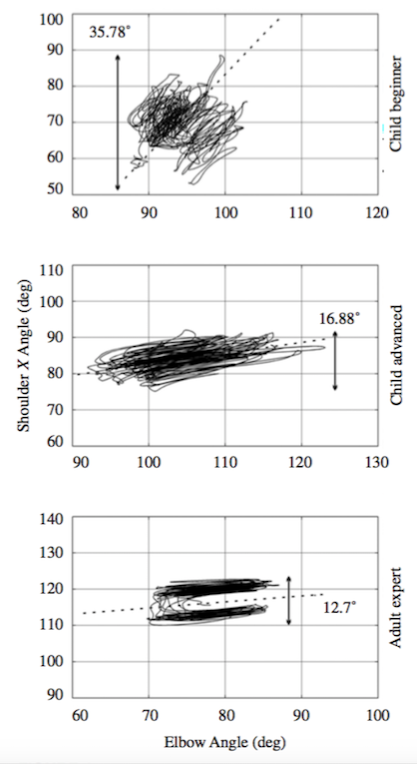
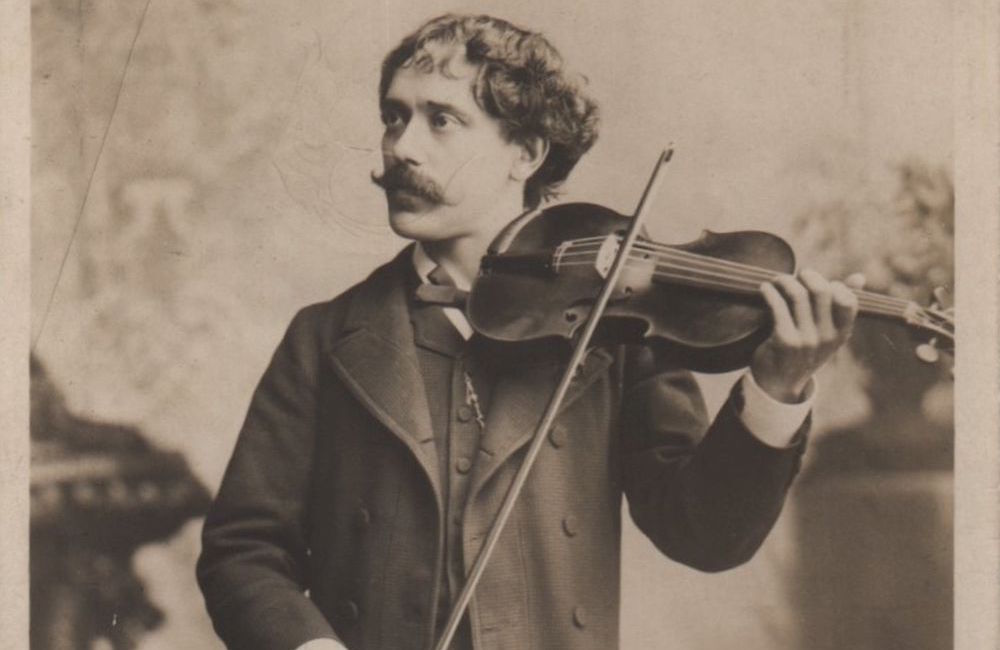
To show this more conclusively the scientists plotted each player’s range of shoulder flexion/extension and range of elbow flexion/extension against their playing experience. A clear decrease in range of shoulder flexion/extension can be seen (top graph, ‘shoulder X ROM’), bottoming out at about 700 hours practice, suggesting that it would take a beginner violinist in excess of 700 hours practice to achieve a restriction of movement in shoulder flexion/extension that is comparable to experts. In contrast, elbow angle range of movement (bottom graph, ‘Elbow ROM’) does not systematically change with practice time (and nor did shoulder adduction/abduction, though that is not shown here):
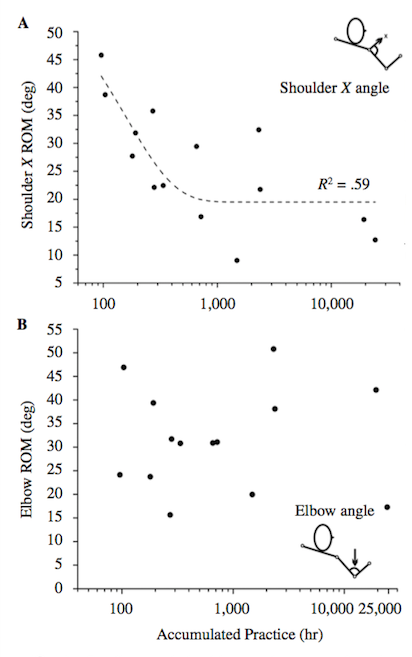
Discussion
The authors conclude: “The main finding of our study was that when young children acquire the skill of playing the violin, the learning of placing and moving the bow more precisely on the strings was not characterized by a successive release of previously suppressed degrees of freedom [joint actions]. Instead, it was the opposite: Joint freezing of the shoulder increased with learning, as documented by the reduction in the amplitude of sagittal [flexion/extension] shoulder motion.” In other words, “Learning to play the violin was not associated with a release of degrees of freedom [joint actions], but was characterized by an experience-dependent suppression of sagittal [flexion/extension] shoulder motion.
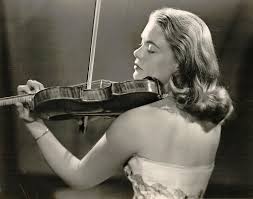
Coda
12 Variations in C Major on ‘Ah, vous dirai-je Maman’ (‘Twinkle Twinkle Little Star’), KV.265 – W. A. Mozart
Piano – Clara Haskil
Interesting article, which I don’t fully understand…(I can’t see how my shoulder is really moving much in any plane, except for string-crossing). But I wanted to point out that in diagram D the strings are labelled the wrong way round – open E is E string, the other three bars are A string.
Hi Debbie, thank you so much for reading the post, and for flagging up that error – very embarrassed I didn’t spot it myself! I’ve now photoshopped the offending letters out of the diagram. I would say that yes the Preece shoulder hasn’t moved in a sagittal plane for many a year, hence the perfectly straight bowing arm, it does indeed only move in one plane (the frontal plane) to effect string crossing. The point being that beginners’ shoulders move all over the place so they have to learn to ‘freeze’ its movements in the sagittal plane (the movement that cause bow slippage). Can’t wait to see you back at work, or maybe in the vaccine queue first, thanks again, Adrian